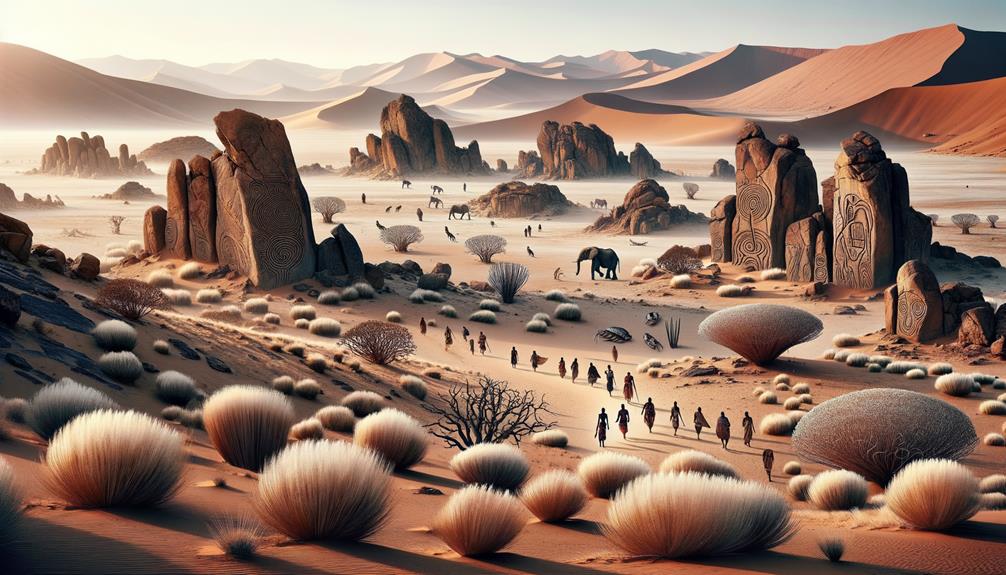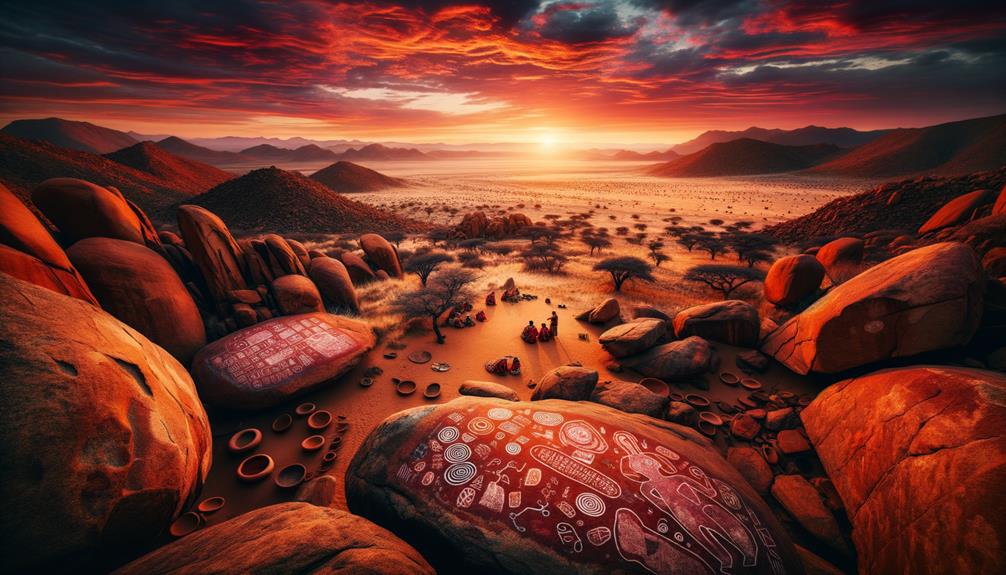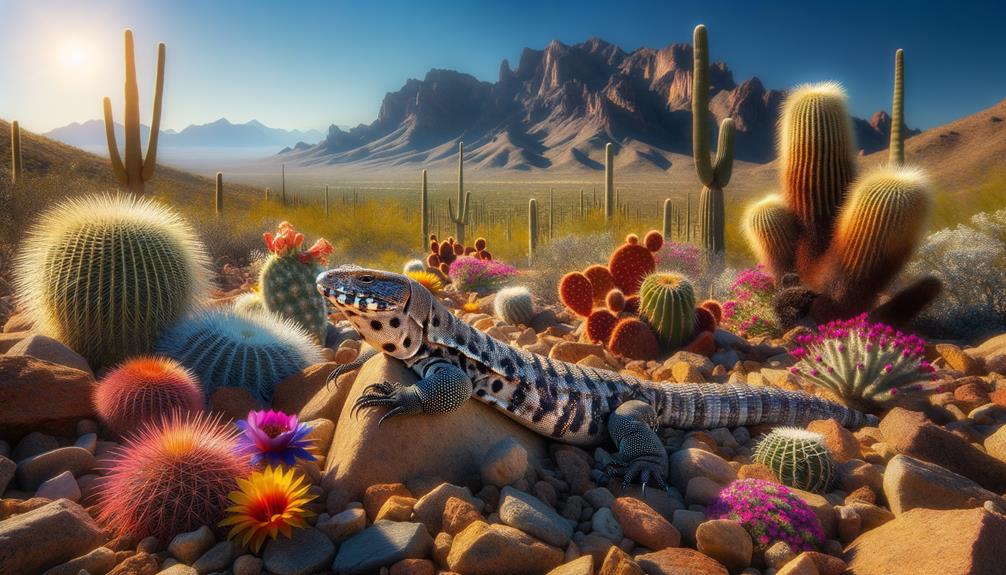The Namib Desert has been home to the San and Khoikhoi peoples for thousands of years. These ancient inhabitants developed unique ways to survive in the harsh desert environment. The San were skilled hunter-gatherers, using bows, arrows, and a deep understanding of plant poisons to catch their prey. Meanwhile, the women gathered a diverse range of plant foods. The Khoikhoi, on the other hand, were pastoralists who herded livestock and traded with the San. They developed innovative methods for storing water, using ostrich eggshells, and gained a deep understanding of over 100 species. Their rock art and trance dances reflect their profound connection to the land. As you delve deeper, you'll uncover the complexity of their survival strategies and cultural practices.
Key Takeaways
The San and Khoikhoi peoples have called the Namib Desert home for thousands of years. The San people were skilled hunter-gatherers, with a deep understanding of the desert's flora and fauna. They lived a semi-nomadic lifestyle, moving between locations to find food and resources. In contrast, the Khoikhoi, also known as the Nama people, were pastoralists who herded sheep and cattle. Despite their differences, the San and Khoikhoi worked together, often cooperating to achieve mutual benefits. However, the arrival of colonizers in the 17th to 19th centuries disrupted their traditional ways of life. Despite these challenges, both groups have managed to preserve elements of their cultural heritage.
Indigenous Groups of the Namib
The San and Khoikhoi peoples have lived in the Namib Desert for thousands of years, their cultures deeply intertwined with the harsh landscape. The San people, also known as Bushmen, were semi-nomadic hunter-gatherers who relied on their extensive knowledge of the desert's flora and fauna to survive. Their unique click languages are some of the most distinctive in the world.
In contrast, the Khoikhoi, or Nama people, were pastoralists who herded sheep and cattle. They spoke the Nama language and had a symbiotic relationship with the San, engaging in trade that benefited both groups. The traditional ways of life for these indigenous groups were rooted in their cultural heritage, reflecting a profound connection with the land.
However, the arrival of colonizers in the 17th to 19th centuries severely disrupted these traditional ways of life. Forced labor and other forms of oppression threatened the very existence of these communities. Despite this, some San and Khoikhoi communities have managed to preserve elements of their rich cultural heritage. Their resilience is a testament to their enduring legacy in southern Africa.
Survival Strategies

San people have developed sophisticated survival strategies to thrive in the harsh Namib Desert for thousands of years. Their resourcefulness is evident in how they utilize the desert's limited resources. San women play a vital role in gathering plant-based foods like fruits, berries, tubers, and insects, which complement the meat hunted by the men. Hunting is an art form, with men using bows, arrows, and poison-tipped spears to catch their prey.
Water, a precious commodity in the desert, is ingeniously stored in ostrich eggshells, showcasing the San's ingenuity. They have mastered fire-starting techniques, which are crucial for cooking and protection, and have learned to harvest and safely use poisonous bulb plants. This wealth of knowledge has been passed down through generations, highlighting their deep connection to their environment.
The San's kinship system and social structure, centered around small, mobile foraging bands, enhance their survival. This structure allows them to efficiently exploit limited resources and share knowledge within the community. Evidence of their tool use dating back over 42,000 years underscores the enduring legacy of their survival strategies in the Namib Desert.
Traditional Practices

Building on the survival strategies, I now delve into how the ancient customs and rituals of the San people have sustained their cultural identity amidst the challenges of the Namib Desert. The San, who have roamed these arid lands for over 30,000 years, developed a rich cultural heritage rooted in their environment. Their expertise in hunting and gathering is unmatched, with men skillfully using bows, arrows, and poisoned spears to hunt game while women gather an impressive variety of plant-based foods, from fruits and berries to tubers and insects.
The resourceful use of ostrich eggs as water containers is a testament to their ingenuity. These eggshells, filled at sparse water sources, sustain them during the dry season, when they consume up to 104 different species to meet their nutritional needs. Archaeological evidence, dating back to 42,000 BC, underscores their deep connection to the Kalahari Desert.
The San's kinship system reflects the fluid structure of their small, mobile foraging bands. With children free from social duties and leisure cherished, their traditions emphasize a balance between survival and cultural richness. This blend of practical skills and enduring customs has enabled the San to thrive in one of the world's harshest landscapes.
Ecological Knowledge

Deep in the Namib Desert, I'm struck by the San people's profound understanding of their environment. For at least 42,000 years, they've thrived in this harsh yet vibrant landscape. Archaeological evidence confirms their long history in this unforgiving ecosystem.
The San people's knowledge of local plant and animal species is unmatched. They use over 100 different species for food, medicine, and daily necessities. For example, they utilize the leaves of the Welwitschia mirabilis plant to produce water-absorbing fibers for clothing and rope. Their sophisticated hunting techniques involve crafting poisoned arrows from the Diamphidia beetle, ensuring a steady food supply.
Water, a precious resource in the Namib, is ingeniously harvested. The San people's intricate knowledge of the desert's fog-based ecosystem enables them to collect water from fog-basking beetles and plant condensation. Their adeptness at hunting and gathering, honed over millennia, showcases a remarkable synergy with their environment, epitomizing human resilience and ingenuity.
Cultural Significance

In the heart of the Namib Desert, the rich cultural heritage of the San and Khoikhoi people is deeply intertwined with the ancient landscape. The San's intricate rock art and spiritual trance dances have left a lasting impact on the desert. These trance dances, often accompanied by the use of hallucinogens, are profound expressions of their connection to the Namib.
The cultural significance of the Namib Desert is evident in three key areas:
- Rock Art: The San's rock art provides a vivid glimpse into their world, depicting hunting scenes and spiritual journeys, which offer a unique window into their lives.
The San and Khoikhoi have developed an intimate understanding of the desert's flora and fauna, knowledge that has been threatened by colonialism and displacement. This traditional ecological knowledge is crucial to their survival in the harsh desert environment.
Despite historical challenges, these communities continue to advocate for recognition as the original custodians of the Namib, emphasizing their enduring bond with the land. As we delve deeper into their stories, the San and Khoikhoi remind us of the profound cultural significance of the Namib Desert, a lasting testament to their resilience and enduring legacy.
Frequently Asked Questions
Who Are the Native People of the Namib Desert?
I've researched the native people of the Namib Desert, finding that they are the Khoikhoi and San. The Khoikhoi were skilled herders, while the San thrived as skilled hunters and gatherers. Both tribes developed remarkable adaptations to the harsh desert environment.
What People Live in the Namib Desert?
The Namib Desert is home to the San and Himba people, who have managed to thrive in this harsh environment by blending traditional and modern ways of living. Despite the desert's unforgiving conditions, they continue to uphold their rich cultural heritage.
Which African Desert Is Considered to Be the Oldest in the World?
The Namib Desert is a remarkable natural wonder that has been around for at least 55-80 million years. This African desert's unique climate and dramatic sand dunes are shaped by the cold Benguela Current, making it a fascinating region to explore.
What Are Three Things That Are Strange About the Namib Desert?
The Namib Desert's mystique fascinates me. Imagine a place that's been around for millions of years, with an annual rainfall of less than 2mm, and eerie "fairy circles" scattered across the landscape. These enigmas capture the imagination of anyone seeking adventure and freedom.



